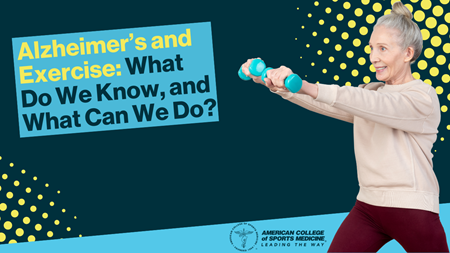Joe Sherlock, ACSM Copywriter |
June
28, 2023
 Author's note: This blog post is based in large part upon “Alzheimer’s Disease and Physical Activity” published in ACSM’s Health & Fitness Journal and authored by Barbara Bushman, ACSM, ACSM-CEP, ACSM-EP, ACSM-CPT, and Madison Pullen, ACSM-EP — a more in-depth piece for readers interested in the nexus of Alzheimer’s and exercise.
Author's note: This blog post is based in large part upon “Alzheimer’s Disease and Physical Activity” published in ACSM’s Health & Fitness Journal and authored by Barbara Bushman, ACSM, ACSM-CEP, ACSM-EP, ACSM-CPT, and Madison Pullen, ACSM-EP — a more in-depth piece for readers interested in the nexus of Alzheimer’s and exercise.
Alzheimer’s disease is “an irreversible, progressive brain disorder that slowly destroys memory and thinking skills, and, eventually, the ability to carry out the simplest tasks”; it is also the most common type of dementia in older adults, representing 60-80% of dementia cases. Approximately 6 million Americans are living with Alzheimer’s disease.
Alzheimer’s is characterized by a number of physical changes in the brain, including the accumulation of abnormal clumps of tissue called amyloid plaques and fibrous accumulations known as tau tangles. Connections between neurons also appear to decrease in number. In later stages, the brain begins to shrink.
These physical alterations correspond to changes in memory, personality, and sensory processing, among other effects, eventually leading to the person becoming incapable of communication and completely reliant on others for their needs.
As for the root causes of the condition, there are likely a number of factors, including genetic predisposition, environmental factors, and matters of lifestyle. More on this last category in a moment.
Staying active
Those who live a sedentary lifestyle are more at risk of developing Alzheimer’s — potentially actionable information for exercise professionals. Further, people who spend their leisure time pursuing various forms of physical activity seem to be less at risk of developing Alzheimer’s than their peers. However, the situation is still murky — it isn’t necessarily clear whether the physical activity itself is in some way protective or rather that other factors involved in the activity, like social interaction, had more of an effect. Other studies suggest that exercise alone, particularly if begun late in life, may not be protective.
Fortunately, attending fitness classes and working one on one with a personal trainer cover both the physical and social bases described above. We certainty can’t say that partnering with a certified exercise professional for regular fitness sessions will reduce the risk of developing Alzheimer’s, but the accumulated benefits of professionally supervised exercise are a major incentive in and of themselves. Pursuing such training seems like a win-win.
Assisting clients with Alzheimer’s
When building a routine either for a client with Alzheimer’s or one who is concerned about Alzheimer’s prevention, you might consider a number of factors, including the most effective exercise modalities and some of the safety concerns unique to this population.
An important first step, as recommended by the current edition of ACSM's Guidelines for Exercise Testing and Prescription, is to perform exercise testing. We must thoroughly understand our clients’ baseline capabilities before we send them off on an exercise prescription. Likewise, it’s best to be in contact with your client’s health care team as well as their family members to better understand their individual case.
Once you’ve established your client’s abilities, what exercise modalities should you pursue? Since Alzheimer’s shares risk factors with cerebrovascular diseases, aerobic exercise may be helpful. However, consider a combined approach of aerobic exercise, resistance training, and flexibility work. Bushman and Pullen provide a handy table, “Exercise Prescriptions for Individuals with AD” in their article outlining appropriate modalities, times, and intensities.
Conclusion
We may not yet know enough about the risk factors behind and causes of Alzheimer’s disease, but encouraging a physically active, social lifestyle over the lifespan may prove beneficial. Encourage your clients to eat well, keep moving, and stay engaged socially. And in the gym or studio, consider a well-balanced routine tailored to each client’s abilities, determined both by exercise testing you yourself administer and by input from their medical team and caregivers.
Related CEC Courses:
Annual Meeting 2023 | Physical Activity and Age-Related Cognitive Function (1 CEC)
Older Adult Exercise | EIM Online Module (2 CECs)